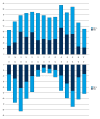Radiological Assessment of Prevalance and Quality of Periapical Status of Endodontic Treatments
- PMID: 35965402
- PMCID: PMC9390538
- DOI: 10.12659/MSM.936569
Radiological Assessment of Prevalance and Quality of Periapical Status of Endodontic Treatments
Abstract
BACKGROUND The aim of this study was to determine the current prevalence and quality of endodontic treatments and investigate the relationship of various factors with posttreatment endodontic disease (PTED) in a Turkish subpopulation. MATERIAL AND METHODS The cone beam computed tomography (CBCT) images of 1069 patients (male, 50.9%; female, 49.1%; mean age, 45.32±13.50 years) were retrospectively analyzed. A total of 20 646 teeth were examined; 1604 had undergone root canal. Periapical status was assessed using a modified CBCT periapical index. The relationship between periapical status and quality of root canal fillings (RCFs) was analyzed statistically using the chi-square test. Multivariate logistic regression was performed to evaluate the effect of individual parameters by adjusting them for other variables. RESULTS A total of 7.8% of all teeth had RCF. The prevalence of poor filling (having at least 1 procedural error) was 54.1%; the prevalence of PTED was 56.8%. The prevalence of PTED was 44.3% in teeth with short RCF, 10.8% with overextended RCF, 35.7% with nonhomogeneous RCF, and 15.5% in teeth with untreated root canals. The rate of RCF teeth with procedural errors associated with PTED was 76.2%. There was no significant difference between sexes in apical periodontitis (P>0.05), which developed more frequently in teeth with procedural errors. CONCLUSIONS The overall prevalence of poor fillings (having at least 1 procedural error) among RCF teeth was high (54.1%) in this subpopulation. There is a substantial need to improve the technical quality of endodontic treatment.
Conflict of interest statement
Figures


Similar articles
-
Prevalence of technical errors and periapical lesions in a sample of endodontically treated teeth: a CBCT analysis.Clin Oral Investig. 2018 Sep;22(7):2495-2503. doi: 10.1007/s00784-018-2344-y. Epub 2018 Jan 21. Clin Oral Investig. 2018. PMID: 29354883
-
Evaluation of technical quality and periapical health of root-filled teeth by using cone-beam CT.J Appl Oral Sci. 2014 Nov-Dec;22(6):502-8. doi: 10.1590/1678-775720140110. J Appl Oral Sci. 2014. PMID: 25591019 Free PMC article.
-
Assessment of periapical health, quality of root canal filling, and coronal restoration by using cone-beam computed tomography.Niger J Clin Pract. 2016 Sep-Oct;19(5):673-7. doi: 10.4103/1119-3077.188697. Niger J Clin Pract. 2016. PMID: 27538559
-
Prevalence of Apical Periodontitis and Conventional Nonsurgical Root Canal Treatment in General Adult Population: An Updated Systematic Review and Meta-analysis of Cross-sectional Studies Published between 2012 and 2020.J Endod. 2020 Oct;46(10):1371-1386.e8. doi: 10.1016/j.joen.2020.07.007. Epub 2020 Jul 14. J Endod. 2020. PMID: 32673634
-
Tooth survival after endodontic treatment.Int Endod J. 2023 Mar;56 Suppl 2:140-153. doi: 10.1111/iej.13835. Epub 2022 Oct 2. Int Endod J. 2023. PMID: 36149887 Review.
Cited by
-
Assessment of endodontic treatment and prevalence of apical periodontitis using cone-beam computed tomography: a cross-sectional study.Pol J Radiol. 2024 Aug 16;89:e391-e401. doi: 10.5114/pjr/190412. eCollection 2024. Pol J Radiol. 2024. PMID: 39257923 Free PMC article.
-
Prevalence of Periapical Radiolucency and Conventional Root Canal Treatment in Adults: A Systematic Review of Cross-Sectional Studies.Cureus. 2023 Jan 3;15(1):e33302. doi: 10.7759/cureus.33302. eCollection 2023 Jan. Cureus. 2023. PMID: 36741594 Free PMC article. Review.
-
Machine Learning to Predict Apical Lesions: A Cross-Sectional and Model Development Study.J Clin Med. 2023 Aug 23;12(17):5464. doi: 10.3390/jcm12175464. J Clin Med. 2023. PMID: 37685531 Free PMC article.
-
A scientometric, visualization, and content analysis on surgical endodontics from inception to 2023.Odontology. 2025 Apr 28. doi: 10.1007/s10266-025-01114-4. Online ahead of print. Odontology. 2025. PMID: 40295410
-
Challenges Assessment in Endodontics Among Undergraduate Students.Cureus. 2023 Aug 9;15(8):e43215. doi: 10.7759/cureus.43215. eCollection 2023 Aug. Cureus. 2023. PMID: 37692626 Free PMC article.
References
-
- Cimmino MA, Hazes JM. Introduction: Value of epidemiological research for clinical practice. Best Pract Res Clin Rheumatol. 2002;16(5):vii–xii. - PubMed
-
- Pigg M, List T, Petersson K, et al. Diagnostic yield of conventional radiographic and cone-beam computed tomographic images in patients with atypical odontalgia. Int Endod J. 2011;44(12):1092–101. - PubMed
-
- Estrela C, Bueno MR, Leles CR, et al. Accuracy of cone beam computed tomography and panoramic and periapical radiography for detection of apical periodontitis. J Endod. 2008;34(3):273–79. - PubMed
-
- Friedman S. Considerations and concepts of case selection in the management of post-treatment endodontic disease (treatment failure) EndodTopics. 2002;1(1):54–78.
-
- Karabucak B, Bunes A, Chehoud C, et al. Prevalence of apical periodontitis in endodontically treated premolars and molars with untreated canal: A cone-beam computed tomography study. J Endod. 2016;42(4):538–41. - PubMed
MeSH terms
LinkOut - more resources
Full Text Sources

